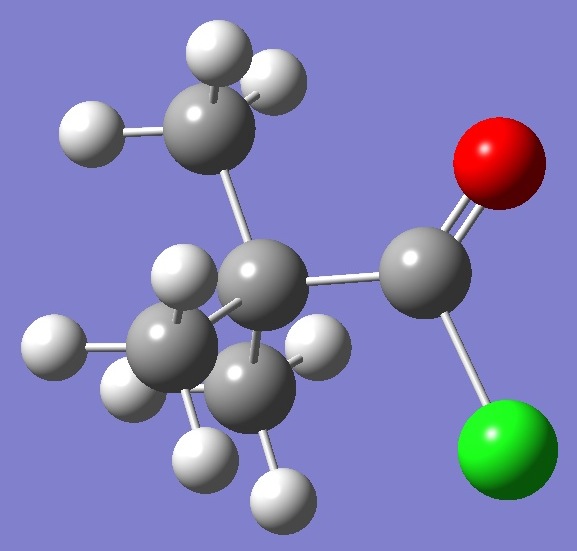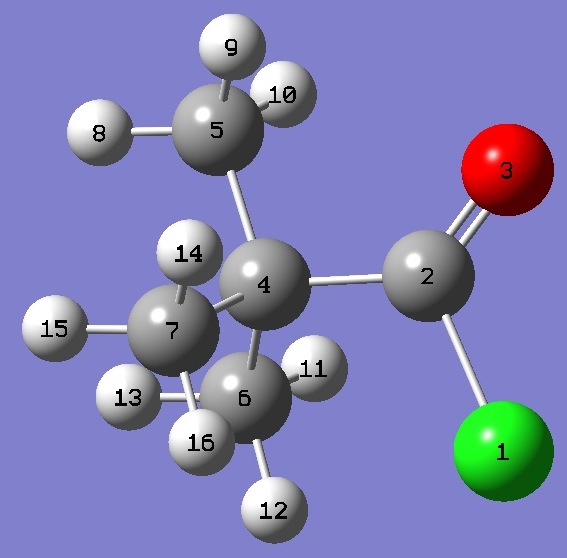|
|
|
|
|
|
|
|
|
|
|
|
|
|
|
|
|
|
|
|
|
(CH3)3C-C(=O)Cl
|
|
|

|
|
|
|
|
|
|
|
|
|
|
|
|
|
|
|
|
|
|
|
|
|
|
|
|
|
|
|
|
|
|
|
|
|
|
|
|
|
|
|
|
|
Chlorine |
|
|
|
Nuclear
Quadrupole Coupling Constants |
|
|
|
in Pivaloyl Chloride |
|
|
|
|
|
|
|
|
|
|
|
|
|
|
|
|
|
|
|
|
|
|
|
|
|
|
|
|
|
|
|
|
|
The complete chlorine nqcc tensors in
pivaloyl chloride have been determined by Grubbs II, et al. [1].
Calculation was made here of the nqcc tensors on approximate
equilibrium (~ re) structures derived as described here.
Calculated and experimental nqcc's are compared in Table 1.
Structure parameters are given in Table 2, rotational constants
in Table 3. |
|
|
|
|
|
|
|
|
|
|
|
|
In Table 1, subscripts a,b,c refer to the principal axes of the inertia
tensor; x,y,z to the principal axes of the nqcc tensor. The
nqcc y-axis is chosen coincident with the inertia c-axis, these are perpendicular
to the molecular symmetry plane. Ø (degrees) is the angle between its subscripted
parameters. ETA = (Xxx - Xyy)/Xzz. |
|
|
RMS is the root mean square difference
between calculated and experimental diagonal nqcc's (percentage of the
average of the magnitudes of the experimental nqcc's). RSD is the
calibration residual standard deviation for the B1LYP/TZV(3df,2p) model
for calculation of the nqcc's, which may be taken as an estimate of the uncertainty in the calculated nqcc's. |
|
|
|
|
|
|
|
|
|
|
|
|
|
|
|
|
|
|
|
|
|
|
| |
|
|
|
|
|
|
|
|
|
Table 1. Chlorine nqcc's in (CH3)3C-C(=O)Cl (MHz). Calculation was made on the ~ re structure, with interatomic angles given by (1) MP2/6-311+G(d,p) and (2) MP2/6-311+G(2d,p) optimization. |
|
|
|
|
|
|
|
|
|
|
|
|
|
Calc (1)
|
|
Calc (2) |
|
Expt. [1] |
|
| |
|
|
|
|
|
|
|
|
|
Xaa(35Cl) |
- |
33.04 |
- |
33.05 |
- |
33.1906(29) |
|
|
Xbb |
|
11.01 |
|
11.10 |
|
10.7040 |
|
|
Xcc |
|
22.03 |
|
21.95 |
|
22.486638(501) |
|
|
|Xab| |
|
43.95 |
|
43.82 |
|
43.590(245) |
|
|
|
|
|
|
|
|
|
|
|
RMS |
|
0.33 (1.5 %) |
|
0.39 (1.8 %) |
|
|
|
|
RSD |
|
0.49 (1.1 %) |
|
0.49 (1.1 %) |
|
|
|
|
|
|
|
|
|
|
|
|
|
Xxx |
|
38.15 |
|
38.09 |
|
|
|
|
Xyy |
|
22.03 |
|
21.95 |
|
|
|
|
Xzz |
- |
60.18 |
- |
60.04 |
|
|
|
|
ETA |
- |
0.268 |
- |
0.269 |
|
|
|
|
Øz,a |
|
31.69 |
|
31.63 |
|
|
|
|
Øa,CCl |
|
33.27 |
|
33.34 |
|
|
|
|
Øz,CCl |
|
1.58 |
|
1.71 |
|
|
|
|
|
|
|
|
|
|
|
|
|
Xaa(37Cl) |
- |
26.73 |
- |
26.74 |
- |
26.8353(23) |
|
|
Xbb |
|
9.37 |
|
9.44 |
|
9.1115 |
|
|
Xcc |
|
17.36 |
|
17.30 |
|
17.72381(401) |
|
|
|Xab| |
|
34.28 |
|
34.18 |
|
33.789(295) |
|
|
|
|
|
|
|
|
|
|
|
RMS |
|
0.26 (1.5 %) |
|
0.32 (1.8 %) |
|
|
|
|
RSD |
|
0.44 (1.1 %) |
|
0.44 (1.1 %) |
|
|
|
|
|
|
|
|
|
|
|
|
|
|
| |
|
|
|
|
|
|
|
|
|
|
|
|
|
|
|
|
|
|
|
|
|
|
|
|
| Table 2. Pivaloyl Chloride. Heavy atom structure parameters, ~ re
with interatomic angles given by (1) MP2/6-311+G(d,p) and (2)
MP2/6-311+G(2d,p) optimization (Å and degrees). The
complete structures are given here in Z-matrix (G03 input) format. |
| |
|
|
|
| Point Group Cs |
|
~ re(1) |
~ re(2) |
|
|
|
|

|
ClC(2) |
1.8097 |
1.8097 |
| C(2)O |
1.1856 |
1.1856 |
| C(2)C(4) |
1.5133 |
1.5133 |
| C(4)C(5) |
1.5237 |
1.5237 |
| C(4)C(6,7) |
1.5277 |
1.5277 |
| ClC(2)O |
119.35 |
118.98 |
| ClC(2)C(4) |
113.59 |
113.56 |
| C(2)C(4)C(5) |
107.66 |
107.49 |
Click on image to enlarge.
|
C(2)C(4)C(6,7) |
109.50 |
109.48 |
|
|
|
|
|
|
|
|
|
|
|
|
|
|
|
|
|
|
|
|
|
|
|
|
|
|
|
|
| Table 3. Pivaloyl Chloride. Rotational constants (MHz). 35Cl species. |
| |
|
|
|
|
| |
|
~ re(1) |
~ re(2) |
Expt. [1] |
|
|
|
|
|
|
A |
3 004.6 |
3 003.1 |
2 977.99378(82) |
|
B |
1 727.5 |
1 728.4 |
1 708.71195(33) |
|
C |
1 441.6 |
1 442.0 |
1 430.038196(182) |
|
|
|
|
|
|
|
|
|
|
|
|
|
|
|
|
|
|
|
|
|
|
|
[1] G.S.Grubbs II, C.T.Dewberry, K.C.Etchison, M.M.Serafin, S.A.Peebles, and S.A.Cooke, J.Mol.Spectrosc. 251,378(2008). |
|
|
|
|
|
|
|
|
|
|
|
|
|
|
|
|
|
|
|
|
|
|
HC(=O)Cl |
FC(=O)Cl |
CH3C(=O)Cl |
CH2BrC(=O)Cl |
|
|
CH2FC(=O)Cl |
HCCC(=O)Cl |
syn-trans-CH2=CH-C(=O)Cl |
|
|
|
|
|
|
|
|
|
|
|
|
|
|
|
|
|
|
|
|
|
|
Table of Contents |
|
|
|
|
|
Molecules/Chlorine |
|
|
|
|
|
|
|
|
|
|
|
|
|
|
|
|
|
|
|
|
|
|
|
|
|
|
|
|
|
|
CH33CCOCl.html |
|
|
|
|
|
|
Last
Modified 4 May 2008 |
|
|
|
|
|
|
|
|
|
|

